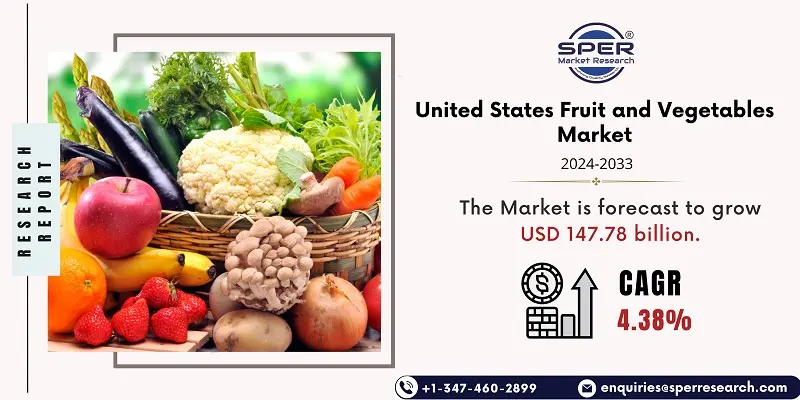
United States Fruit and Vegetables Market Growth, Size, Trends, Demand, Share and Future Outlook
United States Fruit and Vegetables Market Size- By Product, By Distribution Channel- Regional Outlook, Competitive Strategies and Segment Forecast to 2033
| Published: Jun-2024 | Report ID: FOOD2462 | Pages: 1 - 105 | Formats*: |
| Category : Food & Beverages | |||
- The Del Monte Zero pineapple, the company's first certified carbon-neutral pineapple, was introduced in December 2022 by Fresh Del Monte Produce, Inc.
- Sunkist Growers, Inc. launched The Official Orange of American Summer in July 2022 as a way to highlight the Californian orange type. The company provided Valencia oranges with an 8-pound combo bag and matching display bin as part of the advertising and packaging strategy.


| Report Metric | Details |
| Market size available for years | 2020-2033 |
| Base year considered | 2023 |
| Forecast period | 2024-2033 |
| Segments covered | By Product, By Distribution Channel |
| Regions covered | Eastern Region, Western Region, Southern Region, Northern Region |
| Companies Covered | C.H. Robinson Worldwide, Inc., Chiquita Brands International, Inc., Dole Food Company, Inc., Fresh Del Monte Produce, Inc., Fresh Pro, General Mills Inc., Nestlé, Sunkist Growers, Inc., Sysco Corporation, Tanimura & Antle Fresh Foods, Inc., and others. |
- Consumers
- Retailers
- Food Service Industry
- Farmers and Growers
- Distributors and Wholesalers
- Government Agencies and Policy Makers
- Nutritionists and Health Professionals
- Food Manufacturers and Processors
- Exporters and Importers
| By Product: |
|
| By Distribution Channel: |
|
- United States Fruit and Vegetables Market Size (FY’2024-FY’2033)
- Overview of United States Fruit and Vegetables Market
- Segmentation of United States Fruit and Vegetables Market By Product (Fresh Fruits & Vegetables, Dried Fruits & Vegetables, Frozen Fruits & Vegetables)
- Segmentation of United States Fruit and Vegetables Market By Distribution Channel (Supermarkets/Hypermarkets, Grocery Stores, Online, Others)
- Expansion Analysis of United States Fruit and Vegetables Market
- Problems and Obstacles in United States Fruit and Vegetables Market
- Competitive Landscape in the United States Fruit and Vegetables Market
- Impact of COVID-19 and Demonetization on United States Fruit and Vegetables Market
- Details on Current Investment in United States Fruit and Vegetables Market
- Competitive Analysis of United States Fruit and Vegetables Market
- Prominent Players in the United States Fruit and Vegetables Market
- SWOT Analysis of United States Fruit and Vegetables Market
- United States Fruit and Vegetables Market Future Outlook and Projections (FY’2024-FY’2033)
- Recommendations from Analyst
1.1. Scope of the report1.2. Market segment analysis
2.1. Research data source2.1.1. Secondary Data2.1.2. Primary Data2.1.3. SPER’s internal database2.1.4. Premium insight from KOL’s2.2. Market size estimation2.2.1. Top-down and Bottom-up approach2.3. Data triangulation
4.1. Driver, Restraint, Opportunity and Challenges analysis4.1.1. Drivers4.1.2. Restraints4.1.3. Opportunities4.1.4. Challenges4.2. COVID-19 Impacts of the United States Fruit and Vegetables Market
5.1. SWOT Analysis5.1.1. Strengths5.1.2. Weaknesses5.1.3. Opportunities5.1.4. Threats5.2. PESTEL Analysis5.2.1. Political Landscape5.2.2. Economic Landscape5.2.3. Social Landscape5.2.4. Technological Landscape5.2.5. Environmental Landscape5.2.6. Legal Landscape5.3. PORTER’s Five Forces5.3.1. Bargaining power of suppliers5.3.2. Bargaining power of buyers5.3.3. Threat of Substitute5.3.4. Threat of new entrant5.3.5. Competitive rivalry5.4. Heat Map Analysis
6.1. United States Fruit and Vegetables Market Manufacturing Base Distribution, Sales Area, Product Type6.2. Mergers & Acquisitions, Partnerships, Product Launch, and Collaboration in United States Fruit and Vegetables Market
7.1. United States Fruit and Vegetables Market Size, Share and Forecast, By Product Type, 2020-20267.2. United States Fruit and Vegetables Market Size, Share and Forecast, By Product Type, 2027-20337.3. Fresh Fruits & Vegetables7.4. Dried Fruits & Vegetables7.5. Frozen Fruits & Vegetables
8.1. United States Fruit and Vegetables Market Size, Share and Forecast, By Distribution Channel, 2020-20268.2. United States Fruit and Vegetables Market Size, Share and Forecast, By Distribution Channel, 2027-20338.3. Supermarkets/Hypermarkets8.4. Grocery Stores8.5. Online8.6. Others
9.1. United States Fruit and Vegetables Market Size and Market Share
10.1. United States Fruit and Vegetables Market Size and Market Share By Region (2020-2026)10.2. United States Fruit and Vegetables Market Size and Market Share By Region (2027-2033)10.3. Eastern Region10.4. Western Region10.5. Southern Region10.6. Northern Region
11.1. C.H. Robinson Worldwide, Inc.11.1.1. Company details11.1.2. Financial outlook11.1.3. Product summary11.1.4. Recent developments11.2. Chiquita Brands International, Inc.11.2.1. Company details11.2.2. Financial outlook11.2.3. Product summary11.2.4. Recent developments11.3. Dole Food Company, Inc.11.3.1. Company details11.3.2. Financial outlook11.3.3. Product summary11.3.4. Recent developments11.4. Fresh Del Monte Produce, Inc.11.4.1. Company details11.4.2. Financial outlook11.4.3. Product summary11.4.4. Recent developments11.5. Fresh Pro11.5.1. Company details11.5.2. Financial outlook11.5.3. Product summary11.5.4. Recent developments11.6. General Mills Inc.11.6.1. Company details11.6.2. Financial outlook11.6.3. Product summary11.6.4. Recent developments11.7. Nestlé11.7.1. Company details11.7.2. Financial outlook11.7.3. Product summary11.7.4. Recent developments11.8. Sunkist Growers, Inc.11.8.1. Company details11.8.2. Financial outlook11.8.3. Product summary11.8.4. Recent developments11.9. Sysco Corporation11.9.1. Company details11.9.2. Financial outlook11.9.3. Product summary11.9.4. Recent developments11.10. Tanimura & Antle Fresh Foods, Inc.11.10.1. Company details11.10.2. Financial outlook11.10.3. Product summary11.10.4. Recent developments11.11. Others
SPER Market Research’s methodology uses great emphasis on primary research to ensure that the market intelligence insights are up to date, reliable and accurate. Primary interviews are done with players involved in each phase of a supply chain to analyze the market forecasting. The secondary research method is used to help you fully understand how the future markets and the spending patterns look likes.
The report is based on in-depth qualitative and quantitative analysis of the Product Market. The quantitative analysis involves the application of various projection and sampling techniques. The qualitative analysis involves primary interviews, surveys, and vendor briefings. The data gathered as a result of these processes are validated through experts opinion. Our research methodology entails an ideal mixture of primary and secondary initiatives.



Frequently Asked Questions About This Report
PLACE AN ORDER
Year End Discount
Sample Report
Pre-Purchase Inquiry
NEED CUSTOMIZATION?
Request CustomizationCALL OR EMAIL US
100% Secure Payment






Related Reports
Our Global Clients
Our data-driven insights have influenced the strategy of 200+ reputed companies across the globe.




















